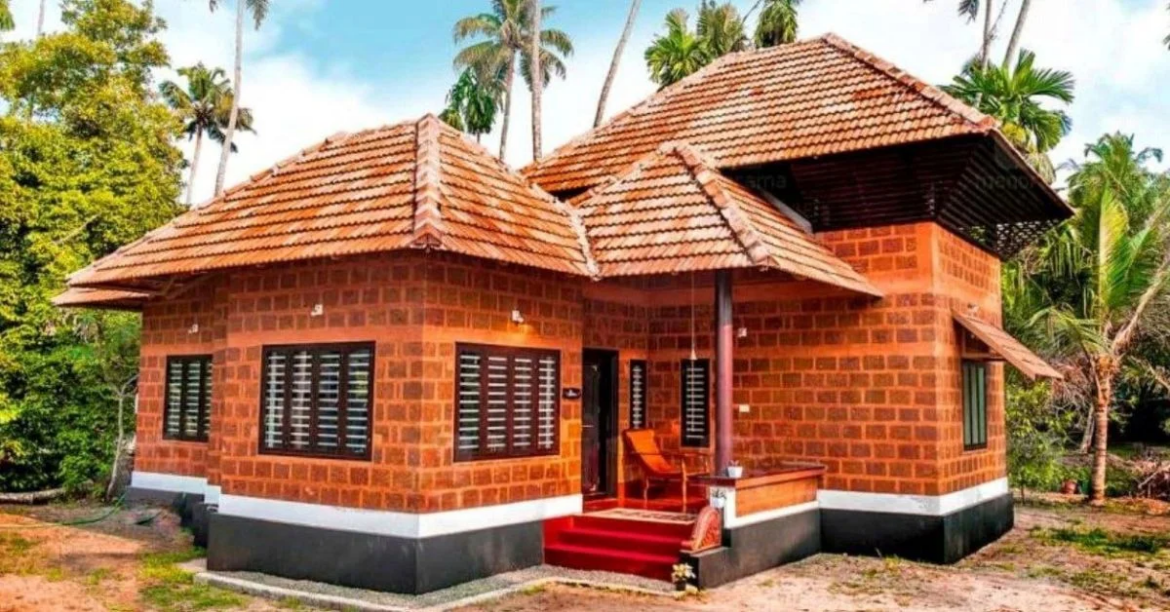In a world where environmental concerns are becoming increasingly prominent, the need for sustainable and eco-friendly living spaces is paramount. Kerala, known for its lush green landscapes and eco-conscious residents, is setting a remarkable example with a sustainable home that not only embraces traditional building techniques but also incorporates innovative ways to save electricity. This article takes you on a journey through a beautiful Kerala home that showcases the perfect blend of tradition and innovation in its design, featuring a red oxide floor and reused roof tiles as key elements in its sustainability journey.
Rediscovering Tradition: The Red Oxide Floor
One of the most striking features of this sustainable Kerala home is its red oxide flooring. Red oxide is not a new concept in Kerala; it has been used for generations in traditional homes across the state. However, in recent times, the popularity of red oxide flooring has waned as modern materials took precedence. Nevertheless, this Kerala home decided to embrace the age-old technique of red oxide flooring, and the results are impressive.
Natural Cooling: Red oxide has a high thermal mass, which means it can absorb and release heat slowly. This property allows the floor to stay cool during hot days, reducing the need for air conditioning and fans, thus saving electricity.
Low Maintenance: Red oxide floors are relatively low maintenance and have a long lifespan, reducing the environmental impact associated with replacing flooring materials frequently.
Local Sourcing: The red oxide used in this home was locally sourced, supporting the regional economy and reducing the carbon footprint associated with transportation.
Repurposing Roof Tiles for Sustainability
Another remarkable feature of this Kerala home is its clever use of reused roof tiles. Instead of opting for new roofing materials, the architects chose to salvage and repurpose old tiles, showcasing the importance of reducing waste and conserving resources.
Reducing Landfill Waste: Reusing roof tiles prevents these materials from ending up in landfills, where they would contribute to environmental degradation.
Energy Efficiency: The process of manufacturing new roof tiles requires energy and resources. By reusing existing tiles, this Kerala home significantly reduced its environmental impact and saved electricity that would have been used in the production of new materials.
Preserving Tradition: Repurposing old roof tiles also honors the rich architectural heritage of Kerala, showcasing the beauty of traditional design techniques.
Other Sustainable Features
Apart from the red oxide floor and reused roof tiles, this Kerala home incorporates several other sustainable features to save electricity and reduce its overall environmental footprint:
Passive Solar Design: The home maximizes natural light and ventilation, reducing the need for artificial lighting and cooling.
Rainwater Harvesting: The house collects rainwater, reducing the dependency on energy-intensive water sources.
Energy-Efficient Appliances: High-efficiency appliances and LED lighting are used throughout the home to minimize electricity consumption.
Solar Panels: The roof of the house is equipped with solar panels to generate clean, renewable energy.
Waste Segregation and Composting: The residents actively practice waste segregation and composting, diverting organic waste from landfills.
Conclusion
This sustainable Kerala home serves as an inspiring example of how traditional building techniques, such as red oxide flooring and reused roof tiles, can be seamlessly integrated with modern innovations to create a home that not only respects the environment but also saves electricity. As we move towards a more sustainable future, embracing such practices becomes essential in reducing our carbon footprint and preserving the beauty of our natural surroundings. Kerala’s commitment to sustainability and its rich architectural heritage provide valuable lessons for all of us in our pursuit of eco-conscious living.

